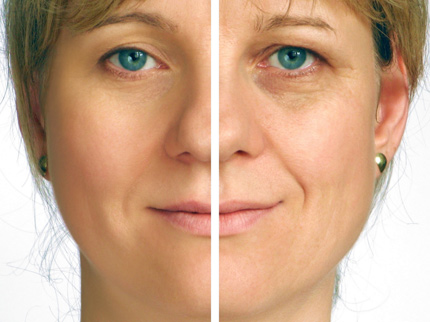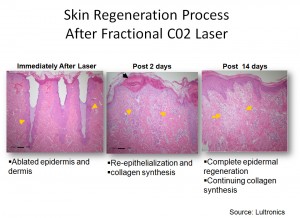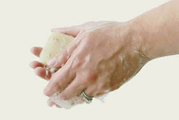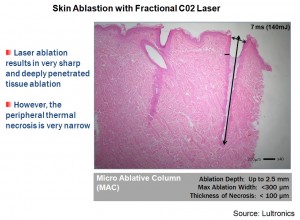Laser Resurfacing
Laser resurfacing: Effective wrinkle treatment
 Laser resurfacing is designed to treat wrinkles and minor facial flaws, but it may not be the best treatment option for you. The following information can help you decide if laser skin resurfacing is a viable and desirable option to help you achieve the look you desire.
Laser resurfacing is designed to treat wrinkles and minor facial flaws, but it may not be the best treatment option for you. The following information can help you decide if laser skin resurfacing is a viable and desirable option to help you achieve the look you desire.
Aging is a natural process we all go through, and along with aging comes wrinkles. While father time is relentless in his march, advances in science and technology have helped slow the march of time thereby helping you reclaim your youthful, glowing skin.
Skin resurfacing, in its many forms, may be the answer you are looking for. Laser resurfacing is quickly becoming the abltative (wounding) skin resurfacing option due to its precision and excellent outcomes. This technique helps to remove sun-damaged and worn skin allowing room for newer, healthier skin to take its place.
While laser resurfacing does offer fantastic benefits, we know that this treatment option is not for everyone. The following information can help you in your decision. We also invite you to contact us as (210) 698-6777 to see if laser skin resurfacing is right for you.
Who is laser resurfacing for?
Laser resurfacing is ideal for people who want to treat:
- Fine to moderate wrinkles
- Liver spots or age spots (solar lentigines)
- Uneven skin tones
- Sun-damaged skin
- Acne or chickenpox scars
- Someone who wants to regain her/his refreshed look
How do you prepare?
Before scheduling laser resurfacing, you need to meet with Dr. Ghohestani to discuss the factors that determine whether this procedure is likely to work well for you. This meeting generally includes:
- Your medical history. Your doctor asks questions about conditions you have or have had, as well as any current medications.
- A physical examination. Dr. Ghohestani conducts a physical examination and inspects your skin.
- Photographs. We take photographs of your face from different angles. Your doctor uses these photos for before-and-after assessments and long-term reviews.
- A discussion of your expectations. You talk about your motivations and expectations. Dr. Ghohestani explains what laser resurfacing can and can’t do for you and what your results might be.
Before surgery, you may also need to:
- Avoid medications containing aspirin or ibuprofen for several days or up to a week before and after surgery. These medications may increase bleeding. Take only those medications approved or prescribed by your surgeon.
- Avoid exposing your skin to the sun preferably up to 8 weeks before surgery and six months after surgery. Too much sun may cause permanent irregular coloration in your facial skin.
- Avoid applying makeup or facial cream the morning of the surgery.
How is laser resurfacing done?
Depending on your elected treatment, an intense beam of light will be used to treat a specific area of your skin. This laser vaporizes fractions of your skin, hence the name fractional CO2. This process promotes collagen generation and synthesis. As the wound heals, newer, smoother, tighter skin is formed.
Laser resurfacing is similar to other ablative techniques (i.e. chemical peels, microdermabrasion, etc.). The difference is that laser resurfacing is more precise in its treatment location and depth. This gives the doctor more control over treating sensitive areas of the skin, such as the skin around the eyes.
How does it work?
Simply put, the laser will create several microscopic holes. The laser is engineered to reach a precise depth to optimize it rejuvenation effect. Generally speaking, the deeper the laser goes, the better the results will be. This ablative technique jump starts the cells into activity, thereby promoting collagen formation deep in the skin and new skin growth on the surface. This combined effect is what makes a laser resurfacing treatment so effective and so popular.
An entire lifetime of blemishes and sun damage can be erased through a simple laser treatment performed at our clinic. The first resurfacing laser was the CO2 laser. Since then, scientists have developed the fractional CO2 laser, which produces similar results with dramatically less risk and less downtime.
How does laser resurfacing renew your skin? (Fractional Co2 skin regeneration)
The fractional CO2 laser is designed to create microscopic columns of precise depth in the skin. This jump starts the body’s natural regenerative powers thereby promoting collagen formation and synthesis. The new collagen improves texture and tone deep in the skin while the epidermal layer renews. This leads to improved skin texture and tone, reduction in wrinkles and scars, and more even pigmentation throughout the treated area. Additionally, deeper wrinkles and acne scars are reduced, re-contoured, and in many instances eliminated, leaving a healthier, more even glow. This regenerative process will continue for six to twelve months after resurfacing. During this time the skin will continue to improve. Fifteen to thirty percent firming can be achieved. Loose eyelids and lax skin is tightened. Resilience and elasticity are restored. Any remaining wrinkles will continue to improve. The procedure lasts 30-60 minutes.
Laser Resurfacing: The Good News
Laser resurfacing can improve fine wrinkles and acne scars. Some lasers (the CO2 and erbium) accomplish this by vaporizing superficial damaged skin cells and allowing the stem cells to regenerate new skin. As a result, it will smooth your skin texture, improve your complexion, and possibly your skin color. Fine wrinkles will be removed and dynamic (deeper) wrinkles will be improved (see Wrinkles for an explanation of dynamic and fine wrinkles). Acne scars will appear less obvious.
The CO2 laser will also tighten your skin by two methods:
- shrinkage of the extracellular matrix that can be seen immediately after the procedure,
- the laser stimulates new collagen production.
Laser Resurfacing: The Bad News
Fractional C02 is your best option to reduce fine lines, get rid of aged spots and look about 10 years younger. Unfortunately, laser surgery is not a panacea. Your wrinkles and acne scars will improve but will not simply vanish, and more than one treatment may be required to achieve the result you desire. Because of a deeper penetration, C02 laser is more painful than AFT/IPL. Also, recovery from some laser procedures is not a snap; the redness may typically last for days or weeks (more below). Interestingly, the longer the redness lasts, the better the final result.
Laser Surgery: How and Why It Works?
To understand why the laser works, you must first appreciate some basics about your wrinkles and acne scars. Wrinkles and acne scars share one very important feature: they are lower than the surrounding skin. Because of this, light casts shadows in them, making them visible. Look in the mirror to convince yourself.  You will see that everywhere there is a wrinkle or acne scar, there is a shadow. If all wrinkles and acne scars were flush with the level of the skin, the eye would not see them because there would be no shadow. Laser resurfacing works because it makes the wrinkles (acne scars) less visible by vaporizing the surrounding skin (as in the case of CO2) and by stimulating collagen production which makes wrinkles less deep (as in the case of the CO2). Because your skin is vaporized (due to the CO2 laser), it is like a burn. Your skin will be oozing and weeping for 1-2 days, since there will be lots of microscopic holes into your skin. The deeper your wrinkles and acne scars, the more treatments you will need. Shallow wrinkles and scars may be vanished with one treatment.
You will see that everywhere there is a wrinkle or acne scar, there is a shadow. If all wrinkles and acne scars were flush with the level of the skin, the eye would not see them because there would be no shadow. Laser resurfacing works because it makes the wrinkles (acne scars) less visible by vaporizing the surrounding skin (as in the case of CO2) and by stimulating collagen production which makes wrinkles less deep (as in the case of the CO2). Because your skin is vaporized (due to the CO2 laser), it is like a burn. Your skin will be oozing and weeping for 1-2 days, since there will be lots of microscopic holes into your skin. The deeper your wrinkles and acne scars, the more treatments you will need. Shallow wrinkles and scars may be vanished with one treatment.
The Advanced Florescent Technology (AFT) or Intense Pulsed Light (IPL) laser is slightly different than the other two in several important ways. First, it does not actually vaporize away the top layer of the skin, so there is no open wound and no recovery period. You may put make-up on immediately and return to work. There is also no discomfort of the procedure, so you do not need to be anesthetized. AFT works by stimulating collagen formation within your skin without removing the older superficial skin layers. Therefore, one treatment with AFT may not be enough to see significant improvement in reducing fine lines. The AFT is, however, very effective in treating pigmented spots. Some may notice improvement is skin texture, age spots as early as the first session. You may need 6-8 sessions to appreciate a significant difference. Typically, 6-8 session of an AFT equals one Fractional Co2 in terms of skin rejuvenation.
Carbon Dioxide Vs. Erbium Laser Vs. AFT/IPL: Which One is Right for You?
Choosing a laser is a very personalized decision and depends on how much improvement you want and how much recovery time you can afford. AFT/IPL is the most popular laser.
If you are looking for a laser to treat your fine wrinkles and aged spots and you want to see the results after one or two sessions, the fractional C02 is the right choice for you.
The fractional carbon dioxide (CO2) laser resurfacing is more effective than Erbium (Fraxel) and AFT (works well on deeper wrinkles and scars) and can surprise you by its immediate effect on resurfacing and skin tightening. The Fractional C02 laser, however, imposes more recovery. Typically, one comes on a Friday to receive the laser treatment and rest at home for 2-3 days before going back to work. Your face will be red for about 7 days; the redness can last for weeks (rare).
Erbium Fraxel provides more modest improvement, less recovery time but it’s less efficient than C02. Therefore, we offer fractional C02 and AFT lasers; AFT laser is an upgraded form of IPL.
If you are patient and prefer less down time, AFT is a great choice. AFT lasers offer less improvement among the three, but have the huge advantage of imposing no recovery time. Multiple AFT/IPL treatments are necessary for obtaining a result close to a Co2 laser. After an AFT laser, you may put your make-up on and return to work immediately. Because AFT imposes no recovery and is effective for wrinkle reduction in some people, it enjoyed a period of great popularity. However, you may see little improvement with each session of AFT; multiple treatment sessions are necessary.
Preparing for Laser Skin Resurfacing:
The following will assist in making your recovery more comfortable:


| Antibacterial soap | Post-operative ointment-White Petrolatum |
| Used for hand washing to help prevent infection. | A post-resurfacing ointment especially formulated to relieve post-operatively discomfort and minimize redness. You need to bring one tube at the day of surgery. Make sure it is pure white petrolatum. |
| Gauze Pads | Straws |
| Non-sterile large 4×4; you can buy them from a drugstore. | To be used if swallowing is a problem. |
| Benadryl Allergy, 25mg | Bottled Water |
| If restless or have itching, you may take two, then one every four hours thereafter. Benadryl may make you sleepy, so take with caution.You cannot drive while taking Benadryl. | For drinking, at least 640z. per day. Drinking at least 8-10 eight oz. bottled water per day will enhance the healing process by replacing fluids lost from oozing and as a natural diuretic to help decrease swelling. Start to drink plenty of water at least 2 weeks before the laser surgery. |
| Extra Strength Tylenol | Small – Water Mist Bottle |
| May take one every four-six hours starting before the laser as needed for pain. Check with your primary care physician. | To be filled with vinegar and water solution to soak the resurfaced areas. Mist resurfaced areas as needed to relieve burning sensation, if any. |
| Hydrocortisone 1% Cream | Vinegar |
| May be used for itching or discomfort only as directed by Dr. Ghohestani. Some are allergic to the cream. | Mix vinegar and water in a ration 1:8 to wash your face after the laser. |
| Antibiotics | Reading Material/Videos |
| We may call you in an antibiotic prior to your surgery day to be taken when you get home from your procedure. Please follow all medication instructions! | It is important to keep your mind occupied during the healing process. |
| Valtrex, 500 mg | XL Shirts |
| This is an antiviral agent which you will start taking the day before surgery. It is normally taken as 500 mg twice a day starting the day before surgery and continued twice a day for the following 7-10 days. | With button-up fronts or large opening to slip over your head easily. |
| Vicodin (pain medication) |
Snacks/Healthy Foods |
| Usually, you feel pain only during the procedure. If needed, we will call in for you prior to your surgery. It should be taken no more than once every six hours after surgery as needed for pain. Most patients use Vicodin only the first day and then are quite comfortable taking Extra Strength Tylenol for discomfort thereafter . | Foods low in sodium and high in nutritional value. Foods high in sodium could put you at risk for unnecessary swelling and discomfort. Foods high in nutritional value will provide much needed vitamins, complex carbohydrates and protein. A diet high in nutritional value will promote healing and help with the rejuvenation process. |
| Artificial tears | Fruit |
| It may be used as needed in the eyes to rinse exudates and soothe eyes while swollen and not closing well. You can buy it from a drugstore. | Eating fruit will accelerate your healing process; try to eat pineapples, apples and celery. |
Facial Skin Resurfacing FAQ’s
How does it work?
Using infrared light the CO2 laser produces pulses of light engineered to create small columns in the skin at a precise depth. These pulses last thousandths of a second and will not char the skin. Throughout the process the clinician will treat and wipe the treated area so the progress can be assessed and monitored. The rest is left up to the body’s natural regenerative processes. Healing mechanisms will kick in leading to smoother, healthier, more natural and youthful looking skin in a matter of weeks.
What parts of my face can you resurface?
The laser is designed to treat any part of the face. Most commonly, patients will ask to be treated near and around the mouth, eyes, and any place where acne scars have left the skin uneven.
Am I awake during the procedure?
Yes. A topical anesthesia is available for patients who are uncomfortable during the procedure.
Does it hurt?
Most patients say that discomfort is minor both during the procedure and throughout recovery. Many describe the feeling being similar to a “slight sunburn.”
Where is the procedure performed?
In-office with Dr. Ghohestani. You will be at our office generally for about 2 hours depending on the sites treated; we first apply a topical anesthesia and then reapply within 20 minutes.
What to expect after the surgery?
A certified staff member will apply dressings to the skin immediately after the surgery. Many patients experience swelling and crusting post-treatment, which is normal. Specific ointments and application instructions are available in order to keep the skin supple. Most patients experience redness after the procedure, which can last up to 4-6 weeks following the surgery. Any activities that would put undue stress on the recovery process are discouraged as this may lead to complications in healing. Healthy lifestyles and diets help to improve the recovery process and are highly recommended. Most importantly, postoperative instructions should be followed in order to ensure proper healing.
Will I be uncomfortable afterwards?
Patients who follow postoperative instructions and guidelines usually describe minimal discomfort throughout the healing process. Following these instructions will minimize infection and improve comfort during the healing process.
When can I go back to work?
Most patients who receive the treatment on Friday can return to work by the following Monday or Tuesday.
How long will I be red?
The skin’s surface will heal within 7-10 days. Any remaining redness can be addressed with a light makeup. Generally speaking, most patients’ redness is erased within 7-20 days, depending on skin type. Lengthy exposure to the sun is highly discouraged as the recovering skin will be highly sensitive to UV light. If you need to go outdoors, make sure to use a hat and some good sunblock to protect your skin from the sun’s harmful rays.
What about skin color and resurfacing?
Light and medium complexions are generally best-suited for laser resurfacing. Individuals with darker pigmentation require great caution as hyperpigmentation (skin darkening) is a potential risk. Individuals with darker skin are encouraged to meet with Dr. Ghohestani to discuss treatment options. Dr. Ghohestani may test the skin and provide a topical ointment that can help reduce the effects of hyperpigmentation.
How much improvement will I get?
Wrinkles, colors, and scars generally improve by 60-100%. Individuals who seek the treatment for aging skin usually describe looking younger for 10 to 15 years following the procedure.
How long does it last?
The length of improvement is directly tied to how well an individual takes care of his/her skin. Good skin care (i.e. proper use of sunscreen, moderation in sun exposure, etc.) can help results last for several years.
How much does it cost, and will insurance cover it?
On average, a full-face resurfacing using topical anesthesia will cost $2,799. These prices fluctuate depending on the area being treated (i.e. Upper or Lower Eye Lid resurfacing costs an average of $999). All fees are subject to change and not reimbursable by insurance. Call our office to learn more about our specials and monthly pricing.
How do I get started?
Contact our office at 210-698-6777 and schedule a personal consultation with Dr. Ghohestani, our world-renowned dermatologist to discuss your specific needs. He will address your concerns, answer your questions, and recommend the best treatment option for you. Before and after photos of satisfied patients are available to show you the beautiful skin that is possible, no matter what your age or skin condition.
******
Why should you choose Texas Institute of Dermatology for your laser resurfacing?
At the Texas Institute of Dermatology, we want you to have an excellent outcome and to feel that your needs and concerns have been promptly addressed in a caring and sensitive fashion. We strive diligently to ensure your satisfaction, comfort, privacy, and safety. All treatments are supervised or performed by a dermatologist with many years of successful experience in a large variety of procedures. Many treatment modalities are available, and we can recommend the one or two that are most likely to meet your needs; we’re here to meet your needs and help you realize your aspirations. At our clinic in San Antonio, Texas, we serve communities throughout Bexar and Kendall counties, including San Antonio, Boerne, Leon Springs, Fair Oaks Ranch, Canyon Lake city; many of our patients also come from San Marcos, New Braunfels, Kerrville, Austin, Wimberley and Corpus Christi.







